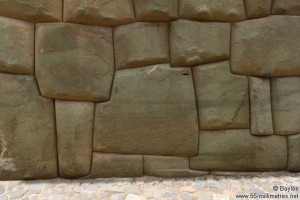Sigiriya
Cuzco
Cuzco is a provincial capital of modern Peru, which in the 11th century was the capital of the Inca Empire. One remarkable sight in the city is the 12-angle stone in the wall on Hatun Rumiyoc Street, which has now been outdone by a 13-angle stone, recently identified, which is built into an irrigation system at the Inkawasi archaeological site, located in Huancavelica region’s Huaytará district(c). The astonishing mortarless Inca masonry in the town has to be seen to be believed.
A few years ago Davide Andrea published his theory on how the Incas fitted those multi-angled stones(d). April Holloway has touched on the suggestion that the Incas or their predecessors had discovered how to soften stone(g). An extensive four-part article elsewhere(h) focuses on the Sri Lankan site of Sigiriya. where what appears to be numerous examples of softened stone can be seen. However, the author concluded that what was on display were features that had been cast in situ and that the same method had been employed when building the pyramids and creating the huge monoliths of Baalbek! It is worth noting that Andrea concluded that “we’re still unsure of how the Incas fit the stones so perfectly”.
The city of Cuzco contained The Corichancha, (Place of Gold), which the Incas dedicated to Viracocha and which astounded the Conquistadors in the 1530s when confronted with its opulence(b). It was  covered inside and out with over 700 sheets of gold and silver. The nearby Garden of the Sun contained golden animals, birds and plants. Pipes, aqueducts and basins were also made of gold. The complex was fed by natural hot and cold springs. Apart from all this ostentatious wealth, some writers have drawn further parallels between Plato’s Atlantis, Homer’s Phaeacia and the Cuzco of the Incas. Although nobody, so far, has suggested that Cuzco had been the location of Atlantis it has been mooted that it may have been constructed as a reminder of the glory of a previous homeland. Donnelly considered Peru to be an Atlantean colony. Local people are clearly not unaware of the suggestion that Cuzco has been associated with Plato’s lost city and so you will find the Atlantis Hotel within a few blocks of the main square.
covered inside and out with over 700 sheets of gold and silver. The nearby Garden of the Sun contained golden animals, birds and plants. Pipes, aqueducts and basins were also made of gold. The complex was fed by natural hot and cold springs. Apart from all this ostentatious wealth, some writers have drawn further parallels between Plato’s Atlantis, Homer’s Phaeacia and the Cuzco of the Incas. Although nobody, so far, has suggested that Cuzco had been the location of Atlantis it has been mooted that it may have been constructed as a reminder of the glory of a previous homeland. Donnelly considered Peru to be an Atlantean colony. Local people are clearly not unaware of the suggestion that Cuzco has been associated with Plato’s lost city and so you will find the Atlantis Hotel within a few blocks of the main square.
>Just 2 km north of Cuzco’s main square lies the remarkable fortress/temple of Sacsayhuaman, which is the largest structure ever built by the Inca. The irregular shaped stones used in its construction fit together like a jigsaw puzzle without the use of any mortar.<
Frank Joseph states[102] that north-west of Cuzco there is a sacred mountain whose summit and a village on its southern slope are known as Atalaia. Pre-Inca remains are also to be found in the vicinity of Cuzco, an ancient sun-worshipping city, which was recently discovered to have the highest ultra-violet levels on our planet. For centuries rumours have persisted(a) that a series of tunnels existed under Cuzco. In 2000, a 2 km tunnel was discovered beneath the city by the Spanish archaeologist, Anselm Pi Rambla(f).
Yale University in the United States, and the Universidad Nacional de San Antonio Abad del Cuzco (UNSAAC) in Peru, announced the establishment of an International Center for the Study of Machu Picchu and Inca Culture, in Cuzco. The Centre opened in 2011(a) following the return of hundreds of items looted by Hiram Bingham.
Brian Foerster is convinced that pre-Incan advanced technology was used in the earliest construction of Cusco, an idea that he expands on in a short YouTube video(e).
(a) https://news.yale.edu/2011/10/06/peru-yale-center-study-machu-picchu-and-inca-culture-opens
(b) https://www.world-mysteries.com/mpl_9.htm (offline Feb. 2016) see Archive 2921
(c) https://www.peruviantimes.com/24/thirteen-angled-stone-found-at-inca-site-of-inkawasi/23139/
(d) https://www.davideandrea.com/personal/ideas/inca_stones/index.html
(e) https://www.youtube.com/watch?v=XwDRZ-u8E2Q
(f) See: https://atlantipedia.ie/samples/archive-3915
(g) Could Ancient Peruvians Soften Stone? | Ancient Origins (ancient-origins.net)
(h) How they softened the stone. Sigiriya. Part 1. Softening of the stone. (geolines.ru)
